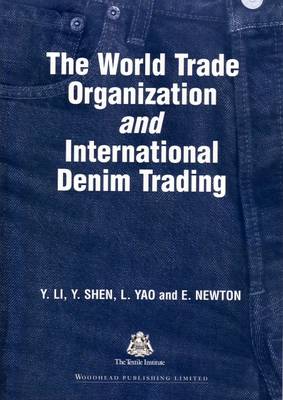Woodhead Publishing Series in Textiles
3 primary works
Book 30
Based on extensive primary research The Chinese and Hong Kong denim industry is the first title of its kind that contains a systematic description and analysis of the denim textile and clothing industry in mainland China and Hong Kong. The authors describe the industry systematically, from yarn, fabric and garment production to distribution channels with a detailed analysis of the industry's competitiveness. The impact of the World Trade Organisation on the industry is also covered along with a comparative study of the textile clothing industries in the top ten exporting countries and regions in world trade.
The Chinese and Hong Kong denim industry is invaluable to companies and individuals interested in the Chinese textile and clothing industry and markets. Universities and students specialising in textiles and clothing, marketing and management will also find this title of use, along with market development managers and market and industry analysts.
The Chinese and Hong Kong denim industry is invaluable to companies and individuals interested in the Chinese textile and clothing industry and markets. Universities and students specialising in textiles and clothing, marketing and management will also find this title of use, along with market development managers and market and industry analysts.
Book 31
The World Trade Organization and International Denim Trading
by Y. Li, K W Yeung, and Y. Shen
Published 1 January 2003
The World Trade Organization and international denim trading is the first market report that focuses on analysing the international denim trading market and its key players. It discusses the important implications of China's entry into the World Trade Organization for the denim industry and analyses the denim trade in the major markets and the key players including USA, EEC, Japan, Hong Kong and China. Included are extensive and systematic primary data research; geographic distributions of denim trade; detailed description and analysis of major markets; comprehensive analysis of industry and its competitiveness and the impact of the World Trade Organisation.
The opening chapter covers international textile and apparel trading; this is followed by China's entry into the World Trade Organisation and its impact on the international textile and apparel trade. The main part of the book reports on denim product trade in specific international markets and the final chapters highlight strategic implications for denim manufacturers and traders.
The opening chapter covers international textile and apparel trading; this is followed by China's entry into the World Trade Organisation and its impact on the international textile and apparel trade. The main part of the book reports on denim product trade in specific international markets and the final chapters highlight strategic implications for denim manufacturers and traders.
Book 51
Human sensory perception of clothing involves a series of complex interactive processes, including physical responses to external stimuli, neurophysiological processes for decoding stimuli through the biosensory and nervous systems inside the body, neural responses to psychological sensations, and psychological processes for formulating preferences and making adaptive feedback reactions.
Clothing biosensory engineering is a systematic and integrative way of translating consumers' biological and sensory responses, and psychological feelings and preferences about clothing, into the perceptual elements of design. It is a link between scientific experimentation and commercial application to develop economic solutions to practical technical problems.
Clothing biosensory engineering quantifies the decision-making processes through which physics, mathematics, neurophysiological and engineering techniques are applied to optimally convert resources to meet various sensory requirements - visual/thermal/mechanical. It includes theoretical and experimental observations, computer simulations, test methods, illustrations and examples of actual product development.
Clothing biosensory engineering is a systematic and integrative way of translating consumers' biological and sensory responses, and psychological feelings and preferences about clothing, into the perceptual elements of design. It is a link between scientific experimentation and commercial application to develop economic solutions to practical technical problems.
Clothing biosensory engineering quantifies the decision-making processes through which physics, mathematics, neurophysiological and engineering techniques are applied to optimally convert resources to meet various sensory requirements - visual/thermal/mechanical. It includes theoretical and experimental observations, computer simulations, test methods, illustrations and examples of actual product development.


